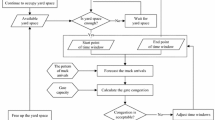Abstract
Management of truck transport in a port area is important for Chinese container ports as heavy traffic congestion not only limits the terminal capacity but also generates serious air pollution. This article explores an effective way to manage the truck traffic of export containers based on a time window management programme that is widely used in Chinese terminals to facilitate terminal and truck delivery operations. Firstly, the arrangement of time windows is assumed to follow the principle of minimizing transport costs. A cost function includes the costs of truck and driver waiting time, fuel consumption associated with truck idling, storage time of the containerized cargos and yard fee. Secondly, to minimize the total cost, a heuristic is developed based on a genetic algorithm to find a near optimal time window arrangement. The optimized solution involves the position and the length of each time window. Finally, the model and the heuristic are tested using real data from a Chinese container terminal, and the result indicates that optimization of the time window can effectively flatten the peak traffic of export container trucks – one of the primary causes of road traffic congestion in port areas.





Similar content being viewed by others
References
Barber, D. and Grobar, L. (2001) Implementing a Statewide Goods Movement Strategy and Performance Measurement of Goods Movement in California. Report of METRANS Transportation Centre, http://www.metrans.org/research/final/99-10_Final.pdf, accessed 03 January 2007.
Chen, G. and Yang, Z. (2008) Traffic demand model for Chinese ports in terms of exported containers operation. Paper presented at the IAME 2008 Annual Conference; 2 April, Dalian, China.
Chinese Ministry of Communications. (1999–2007) National Transport Statistical Yearbook, Various Years from 1999–2007. Beijing, China: Chinese Ministry of Communications, (In Chinese).
Claudio, B. and Marcos, R. (2007) A genetic algorithm for the problem of configuring a hub-and-spoke network for a LTL truck company in Brazil. European Journal of Operation Research 179 (3): 747–758.
Deng, Y. (2007) Developing the distribution system for Chinese ports. Chinese water transport, http://www.port.org.cn/info/200807/110239.htm, accessed 21 July 2008.
Desaulniers, G., Lavigne, J. and Soumis, F. (1998) Multi-depot vehicle scheduling problems with time windows and waiting costs. European Journal of Operational Research 111 (3): 479–494.
Giuliano, G. and Brien, O.T. (2006) Evaluation of the Terminal Gate Appointment Systems at the Los Angeles–Long Beach Ports. METRANS Research Report 04–06, http://www.metrans.org, accessed 12 September 2007.
Giuliano, G. and Brien, O.T. (2007) Reducing port-related truck emissions: The terminal gate appointment system at the Ports of Los Angeles and Long Beach. Transportation Research Part D 12 (7): 460–473.
Giuliano, G. and Brien, O.T. (2008) Responding to increasing port-related freight volumes: Lessons from Los Angeles/Long Beach and other US ports and hinterlands. International transport forum of OECD, http://www.internationaltransportforum.org/jtrc/DiscussionPapers/DP200819.pdf, accessed 30 Dec 2008.
Goodchild, A. and Mohan, K. (2008) The clean trucks program: Evaluation of policy impacts on marine terminal operations. Maritime Economics & Logistics 10 (4): 393–408.
Haveman, J.D. and Hummels, D. (2004) California's Global Gateways: Trends and Issues. San Francisco, CA: Public Policy Institute of California, http://www.ppic.org/content/pubs/report/R_404JHR.pdf, accessed 12 December 2008.
Huynh, N., Walton, C.M. and Davis, J. (2004) Finding the number of yard cranes needed to achieve desired truck turn time at marine container terminals. Transportation Research Record 1873: 99–108.
Huynh, N.N. (2005) Methodologies for reducing truck turn time at marine container terminals. PhD thesis, May, University of Texas.
Lowenthal, D. (2002) Assemble Bill 265, http://info.sen.ca.gov/pub/01-02/bill/asm/ab_2601-2650/ab_2650_cfa_20020822_091111_sen_floor.html, accessed 28 June 2008.
Navis, L.L.C. (2003) Maximize Productivity and Customer Satisfaction With Gate Appointments: Strategy for Terminals. Navis LLC White Paper Series, http://navis.com/images/appointments_wp.pdf, accessed 10 October 2003.
Ozbay, K., Yanmaz-Tuzel, O. and Holguin-Veras, J. (2006) The impacts of time-of-day pricing initiative at NY/NJ port authority facilities car and truck movements. Transportation Research Record 1960: 48–56.
Potvin, J.Y. and Rousseau, J.M. (1993) A parallel route building algorithm for the vehicle routing and scheduling problem with time windows. European Journal of Operational Research 66 (3): 331–340.
Stodolsky, F., Gaines, L. and Vyas, A. (2000) Analysis of Technology Options to Reduce the Fuel Consumption of Idling Trucks. Centre for Transportation Research, Argonne National Laboratory, USA, http://www.transportation.anl.gov/pdfs/TA/15.pdf, accessed 14 December 2008.
Yahalom, S. (2001) Intermodal Productivity and Goods Movement Phase 2: Land Access to Port and Terminal Gate Operations. University Transportation Research Centre, Region II, http://www.utrc2.org/research/assets/35/intermodal1.pdf, accessed 20 October 2008.
Acknowledgements
This study is financed by the Chinese Scholarship Council.
Author information
Authors and Affiliations
Corresponding author
Rights and permissions
About this article
Cite this article
Chen, G., Yang, Z. Optimizing time windows for managing export container arrivals at Chinese container terminals. Marit Econ Logist 12, 111–126 (2010). https://doi.org/10.1057/mel.2009.21
Published:
Issue Date:
DOI: https://doi.org/10.1057/mel.2009.21




